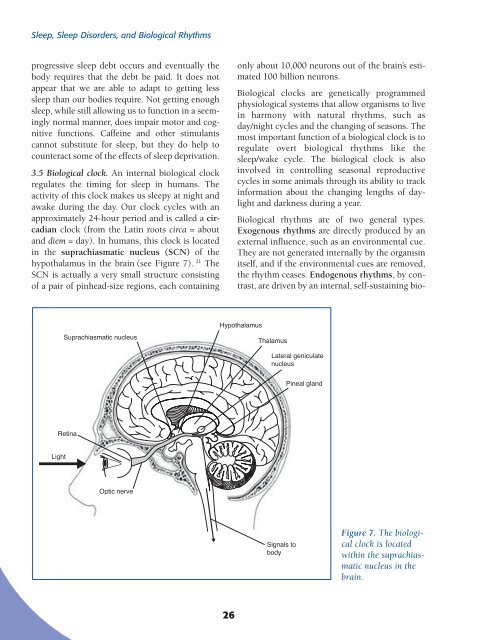Biological - NIH Office of Science Education - National Institutes of ...
Biological - NIH Office of Science Education - National Institutes of ...
Biological - NIH Office of Science Education - National Institutes of ...
Create successful ePaper yourself
Turn your PDF publications into a flip-book with our unique Google optimized e-Paper software.
Sleep, Sleep Disorders, and <strong>Biological</strong> Rhythms<br />
<strong>Biological</strong> rhythms are <strong>of</strong> two general types.<br />
Exogenous rhythms are directly produced by an<br />
external influence, such as an environmental cue.<br />
They are not generated internally by the organism<br />
itself, and if the environmental cues are removed,<br />
the rhythm ceases. Endogenous rhythms, by contrast,<br />
are driven by an internal, self-sustaining bioprogressive<br />
sleep debt occurs and eventually the<br />
body requires that the debt be paid. It does not<br />
appear that we are able to adapt to getting less<br />
sleep than our bodies require. Not getting enough<br />
sleep, while still allowing us to function in a seemingly<br />
normal manner, does impair motor and cognitive<br />
functions. Caffeine and other stimulants<br />
cannot substitute for sleep, but they do help to<br />
counteract some <strong>of</strong> the effects <strong>of</strong> sleep deprivation.<br />
3.5 <strong>Biological</strong> clock. An internal biological clock<br />
regulates the timing for sleep in humans. The<br />
activity <strong>of</strong> this clock makes us sleepy at night and<br />
awake during the day. Our clock cycles with an<br />
approximately 24-hour period and is called a circadian<br />
clock (from the Latin roots circa = about<br />
and diem = day). In humans, this clock is located<br />
in the suprachiasmatic nucleus (SCN) <strong>of</strong> the<br />
hypothalamus in the brain (see Figure 7). 21 The<br />
SCN is actually a very small structure consisting<br />
<strong>of</strong> a pair <strong>of</strong> pinhead-size regions, each containing<br />
only about 10,000 neurons out <strong>of</strong> the brain’s estimated<br />
100 billion neurons.<br />
<strong>Biological</strong> clocks are genetically programmed<br />
physiological systems that allow organisms to live<br />
in harmony with natural rhythms, such as<br />
day/night cycles and the changing <strong>of</strong> seasons. The<br />
most important function <strong>of</strong> a biological clock is to<br />
regulate overt biological rhythms like the<br />
sleep/wake cycle. The biological clock is also<br />
involved in controlling seasonal reproductive<br />
cycles in some animals through its ability to track<br />
information about the changing lengths <strong>of</strong> daylight<br />
and darkness during a year.<br />
Figure 7. The biological<br />
clock is located<br />
within the suprachiasmatic<br />
nucleus in the<br />
brain.<br />
26

















